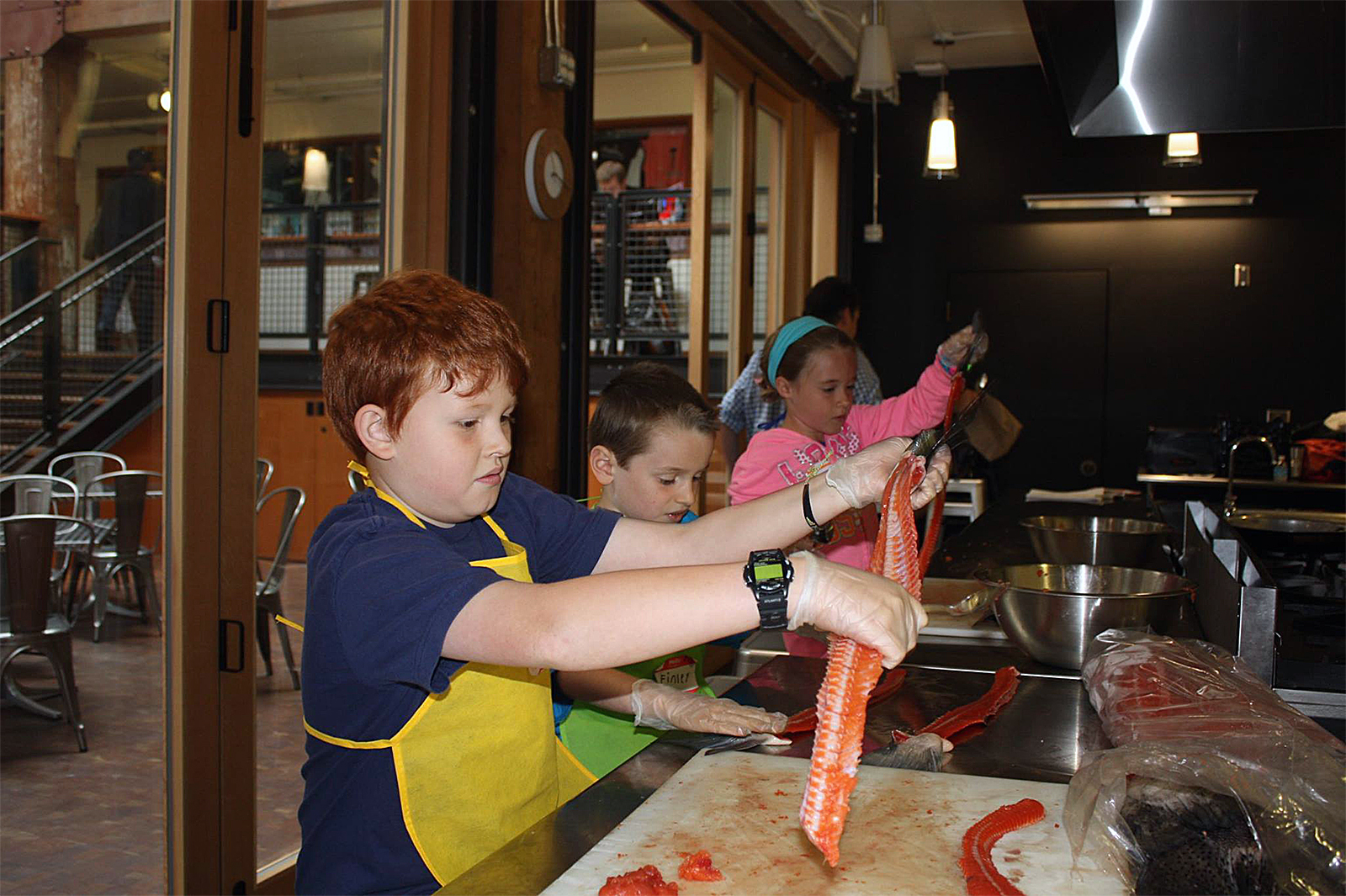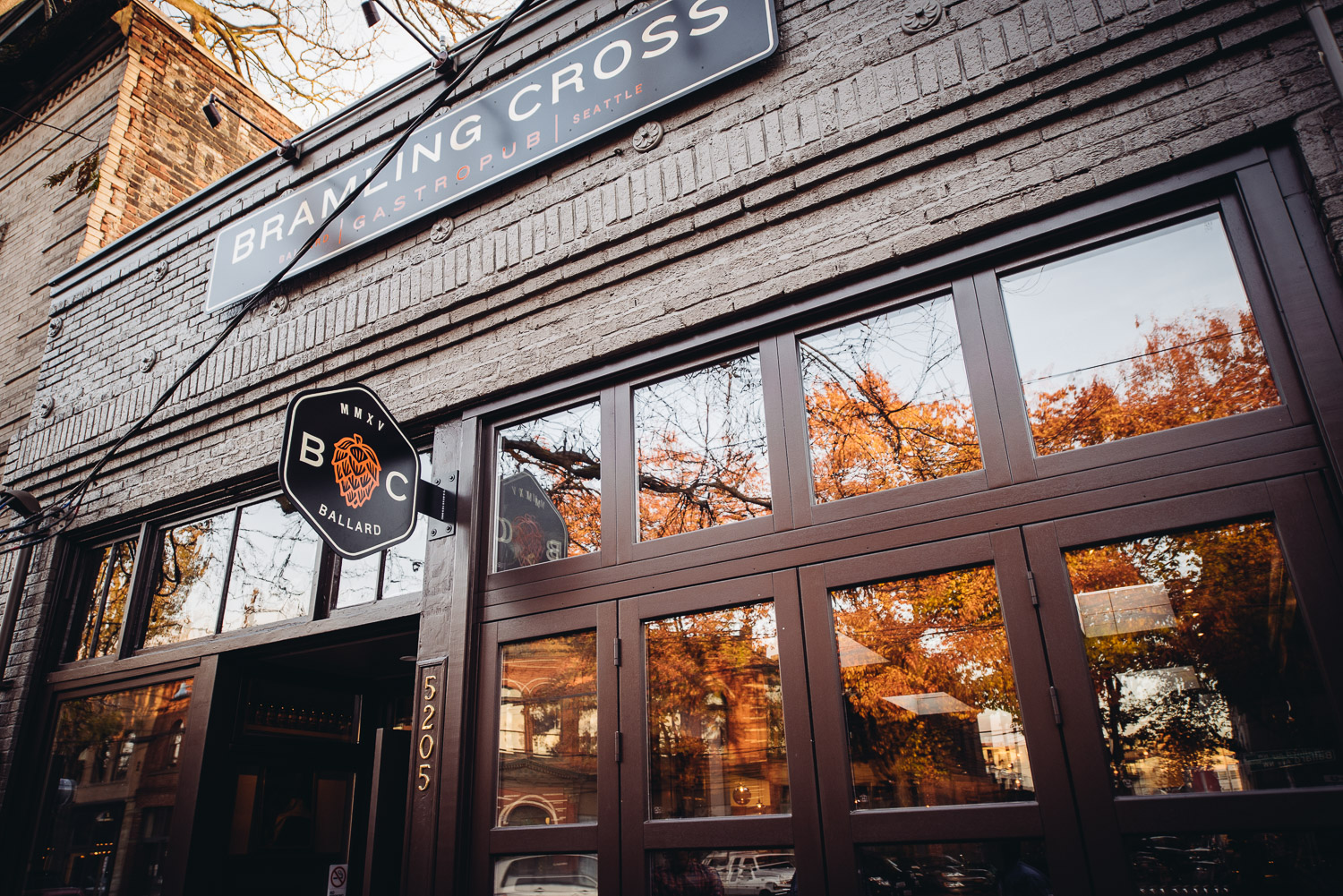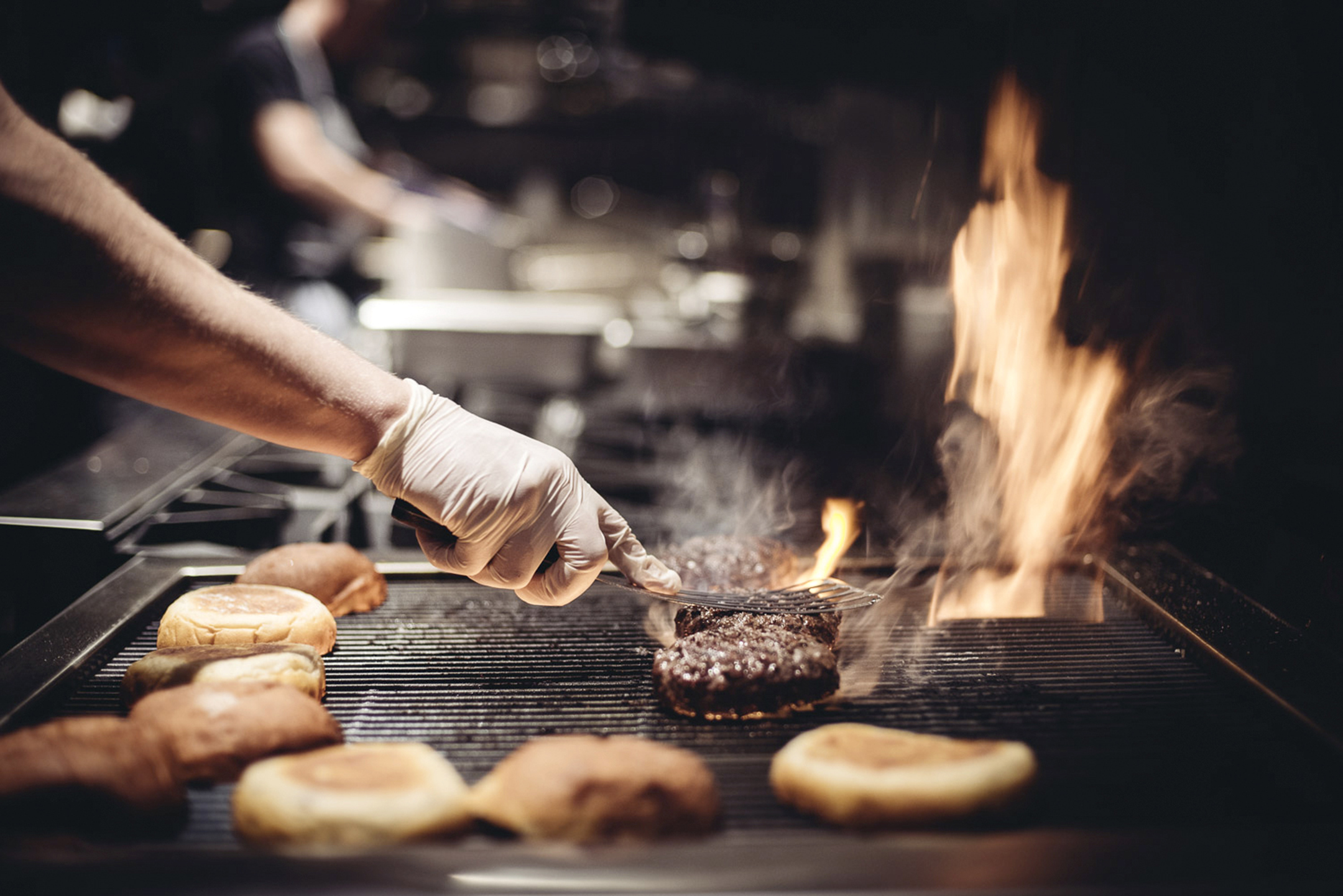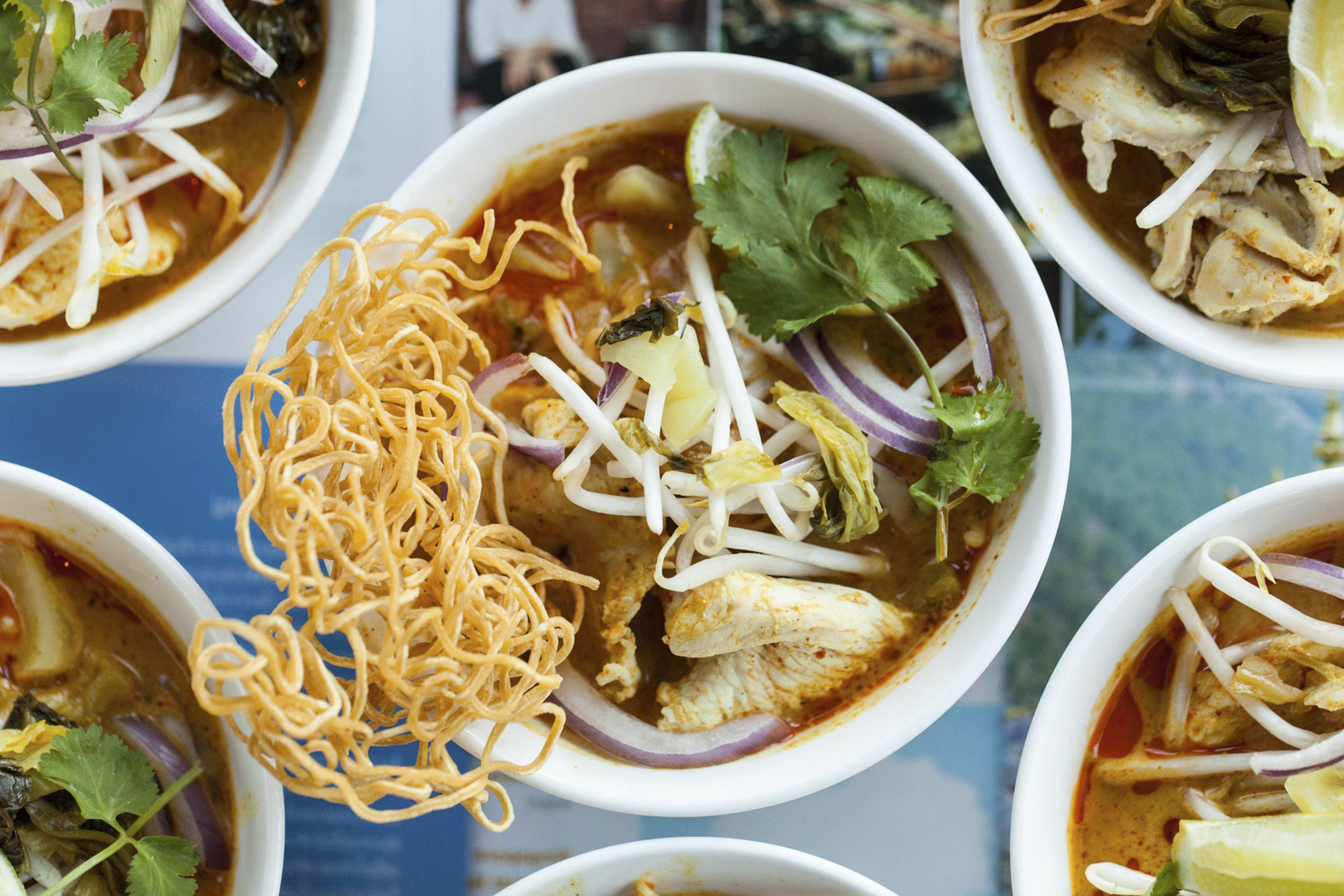A participant gets up close and personal with the salmon at Pike Place Market. Photo by Stephanie Owens
Wow, the spine is so cool!”
“Eww, we found a gut!”
“It’s a living thing, not like it’s a surprise that you would see that… ”
“The boys are going to be really freaked out by this!”
So goes the banter among several 9- to 11-year old girls from the Mercer Island chapter of the Boys and Girls Club. They are gathered in the Pike Place Market Atrium Kitchen, where each is busy scooping orange flesh with a spoon from along the spine of a cleaned salmon set before them, tail still on. Helping the gaggle of girls with the task is Peppa Brower, wife of chef Dre Neeley of Cafe Presse, who is going to cook salmon burgers once the kids are finished with their prep work.
Outside the kitchen, another group of kids is huddled at a table listening to Morgan Bond, a scientist from the University of Washington’s School of Aquatic and Fishery Science who specializes in salmon, talk about everything from how the fish gets its reddish-pink color to the way the female beats her tail against the river bottom until she makes a hole large enough to bury her eggs in.
A third group is outside at Pike Place Fish, where the fishmongers show them different species of salmon, fillet a fish in front of them, and, yes, even allow them a chance to catch a whopping fish.
I’ve come with my 7-year-old daughter to observe the “Seasons of Seafood,” a new dining and educational series put together by Bryan Jarr, former co-owner of Madison Park Conservatory and co-author of In the Kitchen With the Pike Place Fish Guys: 100 Recipes and Tips from the World-Famous Crew of Pike Place Fish. The two-part experience includes a daytime event for kids and a dinner that night for adults cooked by a Seattle chef, also at The Atrium Kitchen.
“The [program] with the kids is to really show them the process from start to finish—from where the fish is sold to making their own meal out of it.”
Scheduled to coincide with a particular type of seafood during its natural release time—coho salmon now, albacore tuna on August 5—the cost of the dinner ($80—$90 for three to four courses with wine) funds the program for the kids. Though the fish-market guys, the chefs, and the scientists donate their time, the Atrium space (for the day and evening event) and the lunch and dinner ingredients need to be paid for.
“The [program] with the kids is to really show them the process from start to finish—from where the fish is sold to making their own meal out of it,” says Jarr, who teamed with Stephanie Owens, a former events planner at Microsoft who recently became a local ambassador for the Jamie Oliver Food Foundation. “The dinner series part is really to take some of the best of the Northwest seafood and let a great Northwest chef do what he or she wants with it.”
Becoming an ambassador isn’t as hard as you’d think—you simply submit an application explaining what you’d like to do in your community that’s aligned with the Foundation’s goals of teaching kids to eat healthy. No money exchanges hands. The Foundation doesn’t fund your project; it just allows you to use their name and logo and share resources with other ambassadors in a closed online community.
“The real goal and mission of this program seems to be getting kids in general excited about cooking and food, real food. So if you live in an area where the school lunches are terrible, that could become your mission. The way I tackled it is to get kids to the Market, and cooking—and getting them making something they may not experience at home,” says Owens. She’s been reaching out to groups like the YMCA and local schools to find willing participants. Though they may eventually try to bring in underprivileged kids, right now the focus is on all kids—because, as she reminds me, “even wealthy kids can eat crappy food.”
Based on what I’m seeing and hearing, they seem to be reaching their goal. As a Pike Place Fish worker hands the kids some smoked salmon to try, I’m shocked at how quickly my daughter eats hers up. She’d never do that if I asked her to try it. She even goes in for seconds.
But then there’s the boy who’s telling his friends he doesn’t like fish. He says his mom makes it at home. I ask him how she prepares it. “Fried,” he answers. His friends keep ribbing him to try it. Finally he gives in. He accepts a piece and I watch him go green. A minute later he’s throwing up in a trash can, his counselor next to him.
“I told you all I didn’t like fish,” he says. I chuckle to myself. But, hey, at least he tried it.
The group of girls I’m with is getting ready for the fish toss. Only two are brave enough to try it. Jarr shows them how to hold their hands to grasp the slippery fish. Then a fishmonger gives him what looks to be about a 20-pounder, probably around a third the size of the girl who’s going to catch it.
We all crowd together as Jarr counts to three and shouts “TT for Becky!” to which we and the rest of the market crowd yell back “TT for Becky!” From about 8 feet, he tosses her the silvery-skinned fish, and we all cheer as she just barely manages to cradle it. Though I’ve seen this ritual umpteen times, rolling my eyes as I try to squeeze past tourists, witnessing it through a child’s exhilaration is completely different—and makes me realize how lucky we are to have such a great resource right at our fingertips. The burgeoning lobster tails, the rows of misshapen oyster shells, the glistening scales of fish—it all looks especially lovely today, like an aquatic jewel case worthy of fantastical mermaids.
“On the car ride home, my daughter rattles off salmon trivia she learned… Bond did his job well.” Illustration by Nina
After all the kids have cycled through the three stations, we meet to sit and eat the meal we’ve prepared together. Brower has a buffet lined up, and everyone grabs a plate, a roll, a beautiful piece of lettuce, a topping of delicious homemade tartar sauce with chopped pickles and dill, a freshly cooked salmon burger, and a side of salad with local blueberries. Again, I’m surprised at how all the kids gobble up the food. I had my doubts at the start; I’ve seen enough picky eaters to be skeptical of pairing salmon burgers and tweens. But other than the kid who can’t stand fish (he eats some salad, along with some fruit his counselor got him from the market), everyone is digging them.I talk to Bond a bit about his work. It’s fascinating. He’s currently studying a subset of salmon that doesn’t end up back in its home stream after being barged through the dams. While barging is ultimately designed to help the salmon survive the perilous dams, it can essentially interrupt their memory so they end up lost—which may then affect their survival rate.
But I’m not the only one who learned something. On the car ride home, my daughter rattles off salmon trivia: how the eggs get their color, why the fish die at the end of their trip home. Bond did his job well.
I ask Jarr about the coolest thing he’s seen from the kids. “A lot of them say they want to grow up and get a job at Pike Place Fish, though I’m not sure they get what that entails,” he jokes. “But, really, it’s just that wow factor. Everything they’re soaking in and their reaction to it. When I did the cooking station, I told them to jump in with their parents and help. We used to learn to cook with our families, not from cooking shows. That’s an important part that you don’t realize until you get older.”
He’s right. I think about all the summer days spent helping my grandmother pick crabmeat from shells and foraging for berries. Being close to that food source—that was priceless.
Though I can’t make it to that night’s dinner with the adults, I check in with Jarr by phone the next day. The dinner, which featured salmon preparations paired with roses, didn’t sell out, but word is getting out. To cover costs—and maybe even pay the servers a little—he needs to get about 60 diners. The August 5 albacore tuna lunch and dinner will feature food from chef Taichi Kitamura of Sushi Kappo Tamura—and maybe some sake cocktails. October’s is with chef Zoi Antonitsas from Westward. At less than $100, it seems a small price to eat local seafood prepared by pros—and perhaps teach a kid something about fish guts.
nsprinkle@seattleweekly.com








